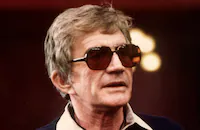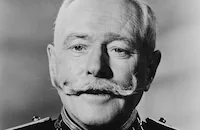The Great Race

Brief Synopsis
Cast & Crew
Blake Edwards
Jack Lemmon
Tony Curtis
Natalie Wood
Peter Falk
Keenan Wynn
Film Details
Technical Specs

Synopsis
In 1908 in New York City, the villainous Professor Fate challenges The Great Leslie to a New York-to-Paris automobile race. Fate and his assistant Max enter their black Hannibal 8 against the white Leslie Special. At the starting line, Fate sets boobytraps for the other competitors and destroys their cars, except for Leslie's and the Stanley Steamer of Maggie DuBois, a feminist reporter for a New York newspaper. Her car breaks down, and she (with pigeons that send dispatches to New York) is picked up by Leslie and leads him to some gasoline that Professor Fate overlooked when he destroyed the supplies. They meet again in Alaska as both cars come to rest on an ice floe. They drift across the Bering Strait to Siberia; Fate then kidnaps Maggie; and both parties make their way to the Baltic republic of Carpania, ruled by Prince Hapnick (who looks exactly like Fate). Evil Baron von Stuppe uses Fate's likeness to begin a revolution. Fate escapes, however, and the race continues into France. Maggie has again joined Leslie, who proves his love for her when he stops his car a few feet from the finish line to kiss her. Fate, some distance behind, catches up with Leslie and is the first to cross the finish line; but he realizes that Leslie was the real winner. The three turn around and head back to New York.

Director

Blake Edwards
Cast

Jack Lemmon

Tony Curtis

Natalie Wood

Peter Falk

Keenan Wynn

Arthur O'connell
Vivian Vance

Dorothy Provine
Larry Storch

George Macready
Ross Martin

Marvin Kaplan
Hal Smith
Denver Pyle
Ken Wales

J. Edward Mckinley

Robert Carson
Paul Smith
Frank Kreig
Charles Fredericks
Clegg Hoyt
Charles Seel
Joe Palma
Paul Bryar
Chester Hayes
Chuck Hayward
Greg Benedict
Robert Herron
William Bryant
John Truax
Johnny Silver
Hal Riddle
Crew
Betty Abbott
Reg Allen
Gordon Bau
Clem Beauchamp
Fernando Carrère
Dick Crockett
Jack Cunningham
Depatie--freleng
Linwood Dunn
Blake Edwards
Don Feld
James Gordon
Sydney Guilaroff
Charles Hansen
Russell Harlan
Edith Head
George James Hopkins
Martin Jurow
Dick Landry
Danny Lee
Henry Mancini
Henry Mancini
Mickey Mccardle
Jack Mcedward
Johnny Mercer
M. A. Merrick
Hermes Pan
Jean Burt Reilly
Arthur Ross
Arthur Ross
Jack Stevens
Ken Wales
Harold Wellman
Ralph E. Winters

Videos
Movie Clip




Trailer
Film Details
Technical Specs

Award Wins
Best Sound Editing
Award Nominations
Best Cinematography
Best Editing
Best Song
Best Sound
Articles
The Great Race
Tony Curtis is the hero, "The Great Leslie," a daredevil and adventurer who enters a 1908 road race starting in New York City and going west to end at the Eiffel Tower in Paris. Leslie wears only immaculately white clothing and his teeth gleam in the sunlight. In pursuit are Leslie's arch-nemesis Professor Fate (Jack Lemmon) and his henchman Max (Peter Falk). Fate always wears black including a black top hat and thick mustache. His car, the "Hannibal 8," is fitted with the latest and most devious devices such as a smoke screen and even a cannon. No old-timey chase comedy would be complete without a damsel in distress and here it is Maggie DuBois (Natalie Wood), an early feminist, who sets out to cover the race and ends up shuttling between the attentions of the Great Leslie and the clutches of the evil Professor Fate.
Director and co-writer Blake Edwards had just made two of the most popular comedies of the early sixties - The Pink Panther (1963) and A Shot in the Dark (1964) - which featured Peter Seller's clumsy Inspector Clouseau. With The Great Race, the director wanted to salute the source of that slapstick on a grand scale. "This is a kind of cartoon I've presented with real-live people," Edwards remarked. "There is a humor in this now that was somewhat inherent in The Pink Panther and A Shot in the Dark but there is almost an unbelievable humor in that you allow things to happen to people, that they could not survive in a million years, for the sake of a laugh. You never explain it. You simply go back and they're all right and you start it again. It's very stylized and yet that's the difficulty of it, to keep the wild style and still maintain enough believability so that you become involved."
Not content just to recreate silent-era comedy, Edwards changes genres with the racers' locations. Their trek through the American West turns the film into a parody of Westerns. When they arrive in the mythical European country of Carpania, Professor Fate's resemblance to the goofy Prince Hapnik (Jack Lemmon in a dual role) sparks a spoof of The Prisoner of Zenda (1952).
Edwards' fought with the producing studio Warner Brothers throughout the making of The Great Race and the result doubled the cost of what was already a large and expensive film. The film was popular, but not enough to make back its cost and began a string of films for Edwards that were failures at the box office but subsequently became cult classics such as The Party (1968). The Great Race has also developed a steadily growing cult following and has inspired other comedies, most notably Yellow Submarine (1968), whose lead villain also has a henchman named Max, and Hanna-Barbera's cartoon television series Wacky Races that replaced Max with a sniggering dog named Muttley.
The Great Race won an Academy Award for Best Sound Effects and was nominated for Best Cinematography, Best Film Editing and Best Song, "The Sweetheart Tree," with music written by Henry Mancini.
Producer: Martin Jurow
Director: Blake Edwards
Screenplay: Arthur A. Ross
Production Design: Fernando Carrere
Cinematography: Russell Harlan
Costume Design: Edith Head, Donfeld
Film Editing: Ralph E. Winters
Original Music: Henry Mancini
Cast: Jack Lemmon (Prof. Fate), Tony Curtis (The Great Leslie), Natalie Wood (Maggie DuBois), Peter Falk (Max), Keenan Wynn (Hezekiah Sturdy), Arthur O'Connell (Henry Goodbody), Dorothy Provine (Lily Olay), Larry Storch (Texas Jack), Ross Martin (Baron Rolfe von Stuppe), George Macready (General Kuhster), Denver Pyle (Sheriff).
C-160m. Closed captioning. Letterboxed.
by Brian Cady

The Great Race
Quotes
We gotta do something.- Max
Oh, don't worry. Before this iceberg melts and we drown like rats, we're going to do plenty.- Professor Fate
Yeah? What?- Max
We're gonna starve!- Professor Fate
You better keep it to yourself.- Leslie
Oh, of course I'll keep it to myself.- Fate
Until the water reaches my lower lip, and then I'm going to mention it to *somebody*!- Fate
Red sky. Gonna be a storm.- Max
What are you babbling about?- Professor Fate
Red sky in the morning, sailor take warning.- Max
Why, you simple-headed gherkin, do you know the chances of a storm in this part of the world at this time of the year?- Professor Fate
No, what?- Max
You! You're the cause of it all! It was your idea!- Prince Hapnick
No, no your highness... Baron von Schtupp- General
I don't care, I don't care! You're banished. I'm getting a new tucker-inner! Banished, banished, banished!- Prince Hapnik
He who fights and runs away, will live to fight another day. Adieu, Mr. Leslie.- The Baron
Trivia
Charlton Heston was originally offered the 'Curtis, Tony' role of The Great Leslie. He considered it a "funny script" but had to turn the part down when the production schedule for The Agony And The Ecstacy was delayed.
Features the largest pie fight ever staged.
Six Hannibal-8 cars were built for the movie. Three of these used the "lazy tongs" lifting mechanism. This mechanism was so fragile that it broke constantly.
The pies used during the pie throwing scene were real, containing fruit, custard, whipped cream and other ingredients. Following this scene the crew devoured more than 300 leftover pies.
The ice floe sequence was shot on the Universal studio back lot during a Southern California heat wave. Temperatures during the filming ran as high as 110 degrees Fahrenheit. The stars were unable to wear the heavy costumes for more than a few minutes at a time.
Notes
Location scenes filmed in Salzburg, Vienna, and Paris. Also reviewed at 150 min and copyrighted at 180 min.

Miscellaneous Notes
Best Cinematography (color), Best Film Editing, Best Original Song ("The Sweetheart Tree"), and Best Sound.
Released in United States Summer July 1, 1965
Released in United States on Video July 18, 1990
Released in United States 2009
Shown at Seattle International Film Festival (Special Presentations) May 21-June 14, 2009.
Released in United States Summer July 1, 1965
Released in United States on Video July 18, 1990
Released in United States 2009 (Shown at Seattle International Film Festival (Special Presentations) May 21-June 14, 2009.)














